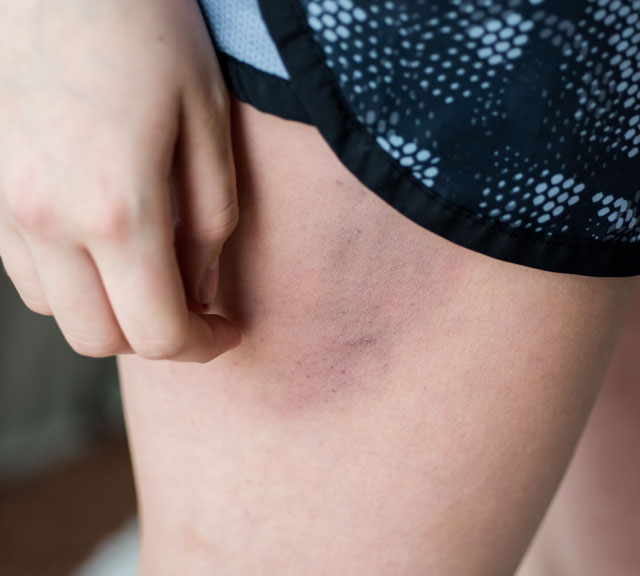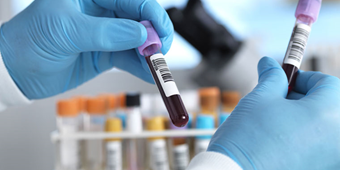Why Won’t the Bleeding Stop?

Find Your Perfect Match
Answer a few questions and we'll provide you with a list of primary care providers that best fit your needs.
Bleeding disorders are a group of conditions that affect the way your blood clots. These conditions can cause abnormal or excessive bleeding outside and inside your body.
When you have a bleeding disorder, your blood does not clot or coagulate properly. The clotting process makes your blood thicken and form a plug at the break in a blood vessel. Too much clotting can lead to heart attacks and strokes or other conditions like deep vein thrombosis. A lack of clot formation can result in dangerous and excessive bleeding.
Blood clots are the main way the body protects against blood loss from injured vessels. Two blood elements, platelets and fibrin, are the primary ingredients in blood clots. Platelets are small circulating blood cells that can stick to the injured vessel wall to form the initial clot. Fibrin is a gel-like substance derived from blood proteins called clotting factors. Fibrin combines with platelets to form a blood clot that prevents blood loss.
Bleeding disorders occur when the blood clotting mechanism does not function properly. Bleeding can occur when clotting factors or platelets are in low supply or if there are problems with the clotting factors or platelets. Abnormal blood vessels can also contribute to bleeding disorders.
Bleeding disorders can be mild or severe. When the blood does not properly clot, bleeding can be heavy and prolonged. Bleeding may also begin on its own without an injury or occur under the skin or in vital organs, such as the brain.
There is no cure for most bleeding disorders, but available treatments can help you feel well and live a normal life while managing your bleeding disorders symptoms.
Hemophilia and Von Willebrand Disease
There are different types of bleeding disorders. The most common are hemophilia and Von Willebrand disease.
Hemophilia is an inherited bleeding disorder that’s relatively rare and affects mostly men. The two most common types are Hemophilia A and Hemophilia B, which put individuals at risk for bleeding due to low levels of critical clotting factors VIII and IX. Very low levels of these clotting factors carry the risk of excessive bleeding after injury due to poor clot formation. If the bleeding is internal, damage to the joints, organs and tissues may occur over time. The severity of hemophilia depends on the levels of functioning clotting factor present in the blood.
The condition can be especially dangerous in children with hemophilia; who tend to be very active and are more likely to be injured.
Von Willebrand disease (VWD) is the most common hereditary bleeding disorder. It’s caused by a deficiency of von Willebrand factor, which helps blood platelets clump together and stick to the blood vessel wall. This is a necessary step for normal blood clotting.
Von Willebrand disease has been classified into three major types based on blood concentration, activity of von Willebrand factor and the blood clotting factor VIII. Type 1 VWD is the most common form and is often mild. Type 3 VWD is the least common form and is usually severe.
Most people with VWD lead normal, active lives. People with mild cases may not require treatment, but should avoid taking drugs that could aggravate bleeding, such as aspirin and ibuprofen, without first consulting with a doctor.
If you have a more serious case, medicines and treatments can increase the level of von Willebrand factor in the blood. It’s important for people with VWD to consult with their doctors before having surgery, having dental work, or giving birth, so that proper precautions can be taken to prevent excessive bleeding.
Genetics, Other Conditions Can Cause Bleeding Disorders
Most bleeding disorders are inherited, which means they’re passed from a parent to a child. Hemophilia, for example, comes from a genetic defect on the X chromosome. The condition is usually passed from women to their sons.
Here’s how: Women have two X chromosomes. Men have one X and one Y chromosome. In women, both X chromosomes must contain the abnormal hemophilia gene to cause hemophilia. Since it is rare for both chromosomes to be affected, women rarely get the disease. Men only have one X chromosome and require only one copy of the gene is to develop hemophilia. This inheritance pattern results in men developing hemophilia much more commonly than women.
A woman hemophilia carrier has only one of two X chromosomes that are positive for the gene. She has a 50 percent chance of passing the gene on to her children. The likelihood of hemophilia developing in a child who receives the hemophilia gene depends on the sex of the child. If a son receives the gene, he will develop hemophilia since only one copy is necessary for men to contract the disease. If a daughter receives the gene, she will not develop hemophilia but will be a carrier of the condition (assuming her father does not have hemophilia).
The inheritance pattern changes if the parent carrying the hemophilia gene is a male. A man with hemophilia has one X chromosome positive for the hemophilia gene and one Y chromosome. His daughters receive the X chromosome and become carriers. His sons receive the Y chromosome and will not be carriers. Thus, no children will contract the disease when the father has hemophilia as long as the mother is not a carrier.
Some women carriers of the hemophilia gene may have mild symptoms of the bleeding disorder because of the random way in which chromosomes are activated.
Bleeding disorders may also be caused by:
- Low platelet counts
- Vitamin K deficiency
- Liver disease
- Side effects from certain medicines, such as anticoagulants and antibiotics
Problems with the number of platelets in the blood or how the platelets are functioning can lead to bleeding disorders. Platelet-related bleeding disorders can be inherited or acquired.
Women with bleeding disorders are at increased risk during their childbearing period for miscarriage or excessive bleeding during childbirth. Women may also experience very heavy menstrual bleeding. These bleeding episodes can lead to anemia, a condition that occurs when your body doesn’t produce enough red blood cells to carry oxygen to your tissues. Anemia can cause weakness, shortness of breath and dizziness. Severe anemia can be life threatening.
If you experience any of these symptoms or conditions, be sure to talk with your doctor right away.
How the Doctor Makes a Diagnosis

To diagnose a bleeding disorder, your doctor will ask you about your symptoms and medical history. Be sure to tell your doctor about:
- Your current medical conditions
- Medicines or supplements you take
- Any recent falls or trauma
Your doctor will examine your body and may perform certain tests to gather more information. It’s important to mention specific details about any abnormal bleeding during your appointment, such as:
- How often you experience the bleeding
- How long the bleeding lasts
- What you were doing before the bleeding began
Blood tests used to diagnose bleeding disorders may include:
- Complete blood count (CBC), which measures the amount of red and white blood cells in your body
- Platelet aggregation test, which checks how well your platelets clump together
- Blood protein clotting tests called partial thromboplastin time (PTT) and prothrombin time (PT)
Treatments Relieve Symptoms, Reduce Complications
There is no cure for most bleeding disorders, but available treatments can help you feel well and live a normal life while managing your bleeding disorders symptoms. Common treatments include:
Iron supplementation: You can take iron supplements to replace the iron your body loses from significant blood loss. Low levels of iron can cause iron deficiency anemia.
Blood transfusion: A blood transfusion replenishes your blood supply with blood from a donor. The donor blood will match your blood type to prevent complications. This procedure is only done in the hospital. You may need a blood transfusion if anemia symptoms don’t improve with iron supplementation.
Factor replacement therapy: Replacing the protein clotting factors missing from your blood can treat hemophilia and Von Willebrand disease. Synthetic blood factors are made in a laboratory by cloning the genes responsible for specific clotting factors. The treatment is pure and safe. The clotting factor concentrate is injected into your bloodstream.
Fresh frozen plasma transfusion: A transfusion of fresh frozen plasma is usually performed to replace blood clotting factors. These transfusions must be done in a hospital.
Platelet transfusion: Platelets are small cells in your blood that help form blood clots. Platelet transfusions are usually performed to replenish a low platelet count. A platelet transfusion may also be used to treat certain blood coagulation factor deficiencies.
Find Your Perfect Match
Answer a few questions and we'll provide you with a list of primary care providers that best fit your needs.
Source: Healthline; Medline Plus; American Society of Hematology




